BUS6001 Report: Sainsbury's Strategic Response to Management Issues
VerifiedAdded on 2023/06/18
|15
|5101
|370
Report
AI Summary
This report examines Sainsbury's strategic response to contemporary management issues, focusing on the impact of Brexit and the acquisition of Argos. It analyzes the drivers of change, including political, economic, and environmental factors, and evaluates Sainsbury's strategic responses using SWOT and PESTLE analyses. The report discusses the challenges posed by Brexit, such as supply chain disruptions and increased costs, and how the acquisition of Argos has helped mitigate these issues. It also considers the impact of globalization, changing consumer preferences, and competitive pressures. The report concludes with recommendations for Sainsbury's to enhance its strategic responses, such as expanding into new markets and investing in sustainability initiatives. Desklib offers a range of solved assignments and past papers to aid students in their studies.
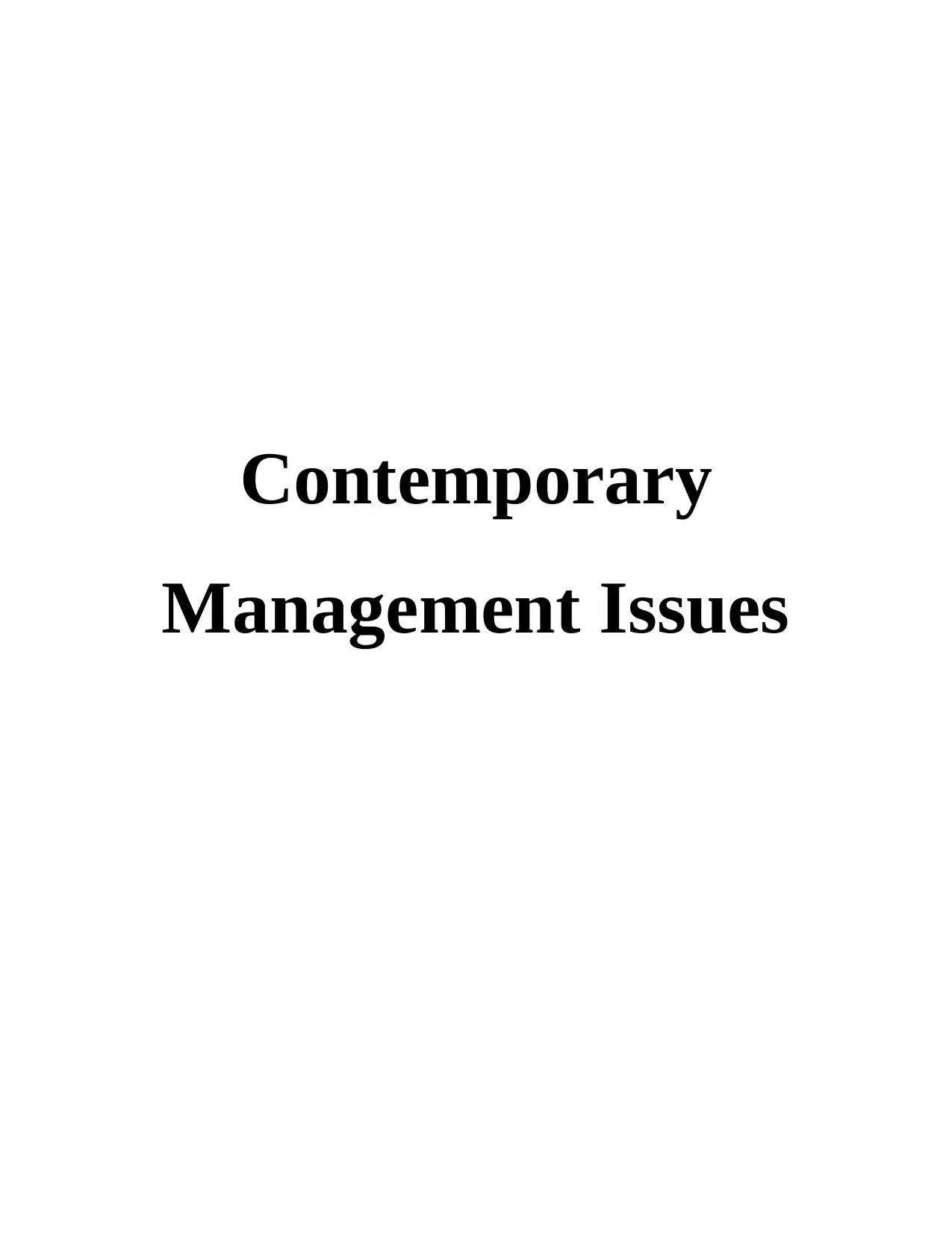
Contemporary
Management Issues
Management Issues
Paraphrase This Document
Need a fresh take? Get an instant paraphrase of this document with our AI Paraphraser
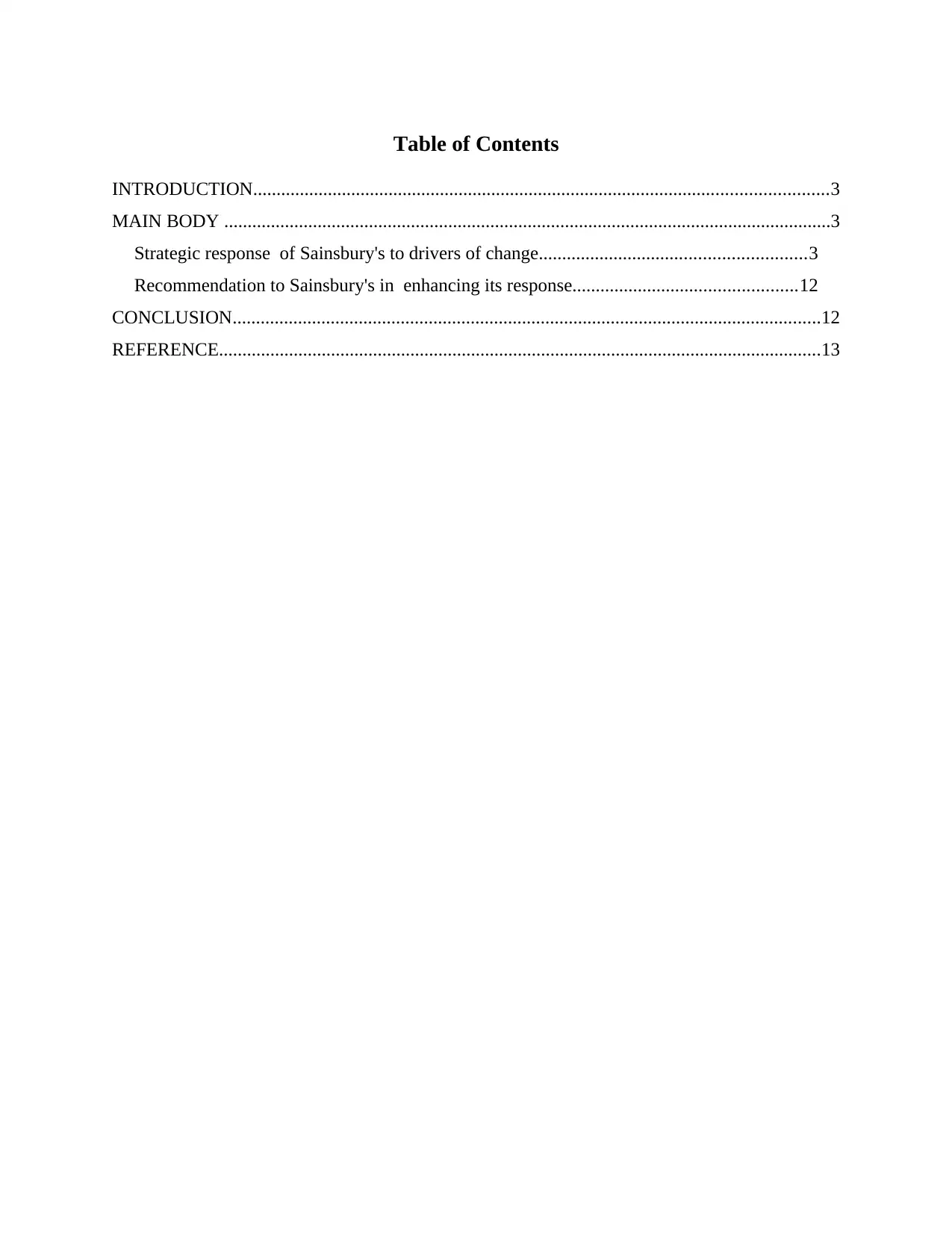
Table of Contents
INTRODUCTION...........................................................................................................................3
MAIN BODY ..................................................................................................................................3
Strategic response of Sainsbury's to drivers of change.........................................................3
Recommendation to Sainsbury's in enhancing its response................................................12
CONCLUSION..............................................................................................................................12
REFERENCE.................................................................................................................................13
INTRODUCTION...........................................................................................................................3
MAIN BODY ..................................................................................................................................3
Strategic response of Sainsbury's to drivers of change.........................................................3
Recommendation to Sainsbury's in enhancing its response................................................12
CONCLUSION..............................................................................................................................12
REFERENCE.................................................................................................................................13
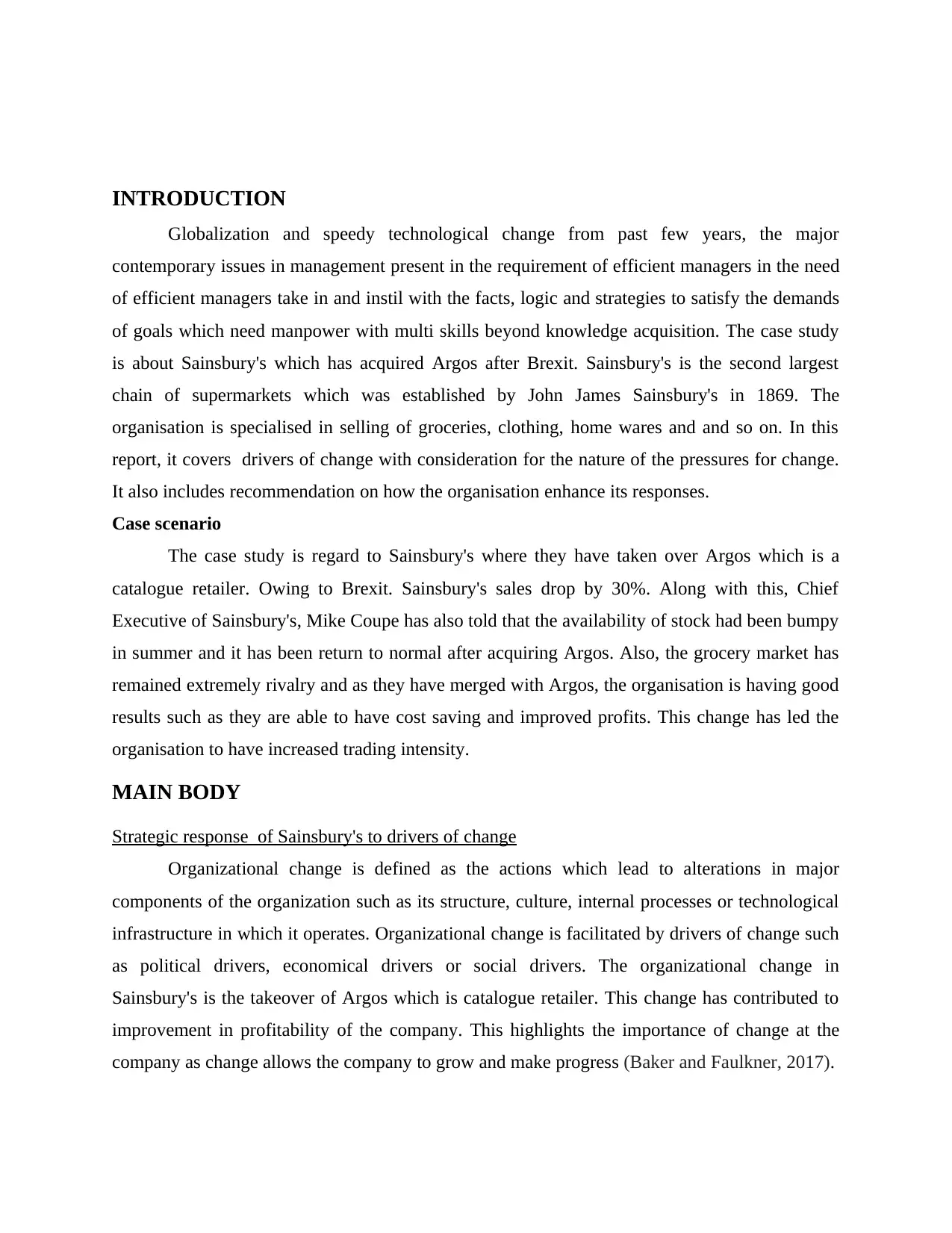
INTRODUCTION
Globalization and speedy technological change from past few years, the major
contemporary issues in management present in the requirement of efficient managers in the need
of efficient managers take in and instil with the facts, logic and strategies to satisfy the demands
of goals which need manpower with multi skills beyond knowledge acquisition. The case study
is about Sainsbury's which has acquired Argos after Brexit. Sainsbury's is the second largest
chain of supermarkets which was established by John James Sainsbury's in 1869. The
organisation is specialised in selling of groceries, clothing, home wares and and so on. In this
report, it covers drivers of change with consideration for the nature of the pressures for change.
It also includes recommendation on how the organisation enhance its responses.
Case scenario
The case study is regard to Sainsbury's where they have taken over Argos which is a
catalogue retailer. Owing to Brexit. Sainsbury's sales drop by 30%. Along with this, Chief
Executive of Sainsbury's, Mike Coupe has also told that the availability of stock had been bumpy
in summer and it has been return to normal after acquiring Argos. Also, the grocery market has
remained extremely rivalry and as they have merged with Argos, the organisation is having good
results such as they are able to have cost saving and improved profits. This change has led the
organisation to have increased trading intensity.
MAIN BODY
Strategic response of Sainsbury's to drivers of change
Organizational change is defined as the actions which lead to alterations in major
components of the organization such as its structure, culture, internal processes or technological
infrastructure in which it operates. Organizational change is facilitated by drivers of change such
as political drivers, economical drivers or social drivers. The organizational change in
Sainsbury's is the takeover of Argos which is catalogue retailer. This change has contributed to
improvement in profitability of the company. This highlights the importance of change at the
company as change allows the company to grow and make progress (Baker and Faulkner, 2017).
Globalization and speedy technological change from past few years, the major
contemporary issues in management present in the requirement of efficient managers in the need
of efficient managers take in and instil with the facts, logic and strategies to satisfy the demands
of goals which need manpower with multi skills beyond knowledge acquisition. The case study
is about Sainsbury's which has acquired Argos after Brexit. Sainsbury's is the second largest
chain of supermarkets which was established by John James Sainsbury's in 1869. The
organisation is specialised in selling of groceries, clothing, home wares and and so on. In this
report, it covers drivers of change with consideration for the nature of the pressures for change.
It also includes recommendation on how the organisation enhance its responses.
Case scenario
The case study is regard to Sainsbury's where they have taken over Argos which is a
catalogue retailer. Owing to Brexit. Sainsbury's sales drop by 30%. Along with this, Chief
Executive of Sainsbury's, Mike Coupe has also told that the availability of stock had been bumpy
in summer and it has been return to normal after acquiring Argos. Also, the grocery market has
remained extremely rivalry and as they have merged with Argos, the organisation is having good
results such as they are able to have cost saving and improved profits. This change has led the
organisation to have increased trading intensity.
MAIN BODY
Strategic response of Sainsbury's to drivers of change
Organizational change is defined as the actions which lead to alterations in major
components of the organization such as its structure, culture, internal processes or technological
infrastructure in which it operates. Organizational change is facilitated by drivers of change such
as political drivers, economical drivers or social drivers. The organizational change in
Sainsbury's is the takeover of Argos which is catalogue retailer. This change has contributed to
improvement in profitability of the company. This highlights the importance of change at the
company as change allows the company to grow and make progress (Baker and Faulkner, 2017).
⊘ This is a preview!⊘
Do you want full access?
Subscribe today to unlock all pages.

Trusted by 1+ million students worldwide
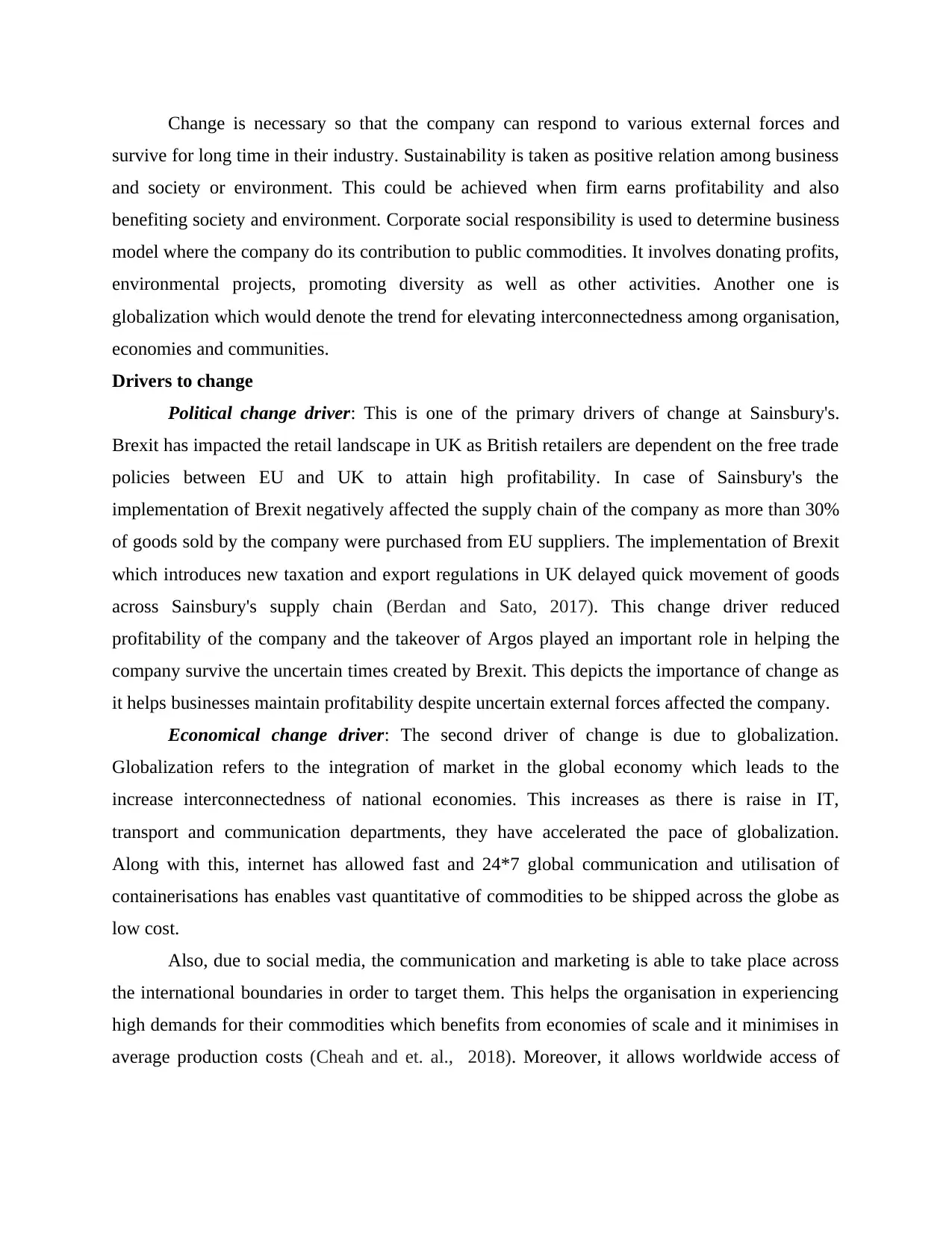
Change is necessary so that the company can respond to various external forces and
survive for long time in their industry. Sustainability is taken as positive relation among business
and society or environment. This could be achieved when firm earns profitability and also
benefiting society and environment. Corporate social responsibility is used to determine business
model where the company do its contribution to public commodities. It involves donating profits,
environmental projects, promoting diversity as well as other activities. Another one is
globalization which would denote the trend for elevating interconnectedness among organisation,
economies and communities.
Drivers to change
Political change driver: This is one of the primary drivers of change at Sainsbury's.
Brexit has impacted the retail landscape in UK as British retailers are dependent on the free trade
policies between EU and UK to attain high profitability. In case of Sainsbury's the
implementation of Brexit negatively affected the supply chain of the company as more than 30%
of goods sold by the company were purchased from EU suppliers. The implementation of Brexit
which introduces new taxation and export regulations in UK delayed quick movement of goods
across Sainsbury's supply chain (Berdan and Sato, 2017). This change driver reduced
profitability of the company and the takeover of Argos played an important role in helping the
company survive the uncertain times created by Brexit. This depicts the importance of change as
it helps businesses maintain profitability despite uncertain external forces affected the company.
Economical change driver: The second driver of change is due to globalization.
Globalization refers to the integration of market in the global economy which leads to the
increase interconnectedness of national economies. This increases as there is raise in IT,
transport and communication departments, they have accelerated the pace of globalization.
Along with this, internet has allowed fast and 24*7 global communication and utilisation of
containerisations has enables vast quantitative of commodities to be shipped across the globe as
low cost.
Also, due to social media, the communication and marketing is able to take place across
the international boundaries in order to target them. This helps the organisation in experiencing
high demands for their commodities which benefits from economies of scale and it minimises in
average production costs (Cheah and et. al., 2018). Moreover, it allows worldwide access of
survive for long time in their industry. Sustainability is taken as positive relation among business
and society or environment. This could be achieved when firm earns profitability and also
benefiting society and environment. Corporate social responsibility is used to determine business
model where the company do its contribution to public commodities. It involves donating profits,
environmental projects, promoting diversity as well as other activities. Another one is
globalization which would denote the trend for elevating interconnectedness among organisation,
economies and communities.
Drivers to change
Political change driver: This is one of the primary drivers of change at Sainsbury's.
Brexit has impacted the retail landscape in UK as British retailers are dependent on the free trade
policies between EU and UK to attain high profitability. In case of Sainsbury's the
implementation of Brexit negatively affected the supply chain of the company as more than 30%
of goods sold by the company were purchased from EU suppliers. The implementation of Brexit
which introduces new taxation and export regulations in UK delayed quick movement of goods
across Sainsbury's supply chain (Berdan and Sato, 2017). This change driver reduced
profitability of the company and the takeover of Argos played an important role in helping the
company survive the uncertain times created by Brexit. This depicts the importance of change as
it helps businesses maintain profitability despite uncertain external forces affected the company.
Economical change driver: The second driver of change is due to globalization.
Globalization refers to the integration of market in the global economy which leads to the
increase interconnectedness of national economies. This increases as there is raise in IT,
transport and communication departments, they have accelerated the pace of globalization.
Along with this, internet has allowed fast and 24*7 global communication and utilisation of
containerisations has enables vast quantitative of commodities to be shipped across the globe as
low cost.
Also, due to social media, the communication and marketing is able to take place across
the international boundaries in order to target them. This helps the organisation in experiencing
high demands for their commodities which benefits from economies of scale and it minimises in
average production costs (Cheah and et. al., 2018). Moreover, it allows worldwide access of
Paraphrase This Document
Need a fresh take? Get an instant paraphrase of this document with our AI Paraphraser
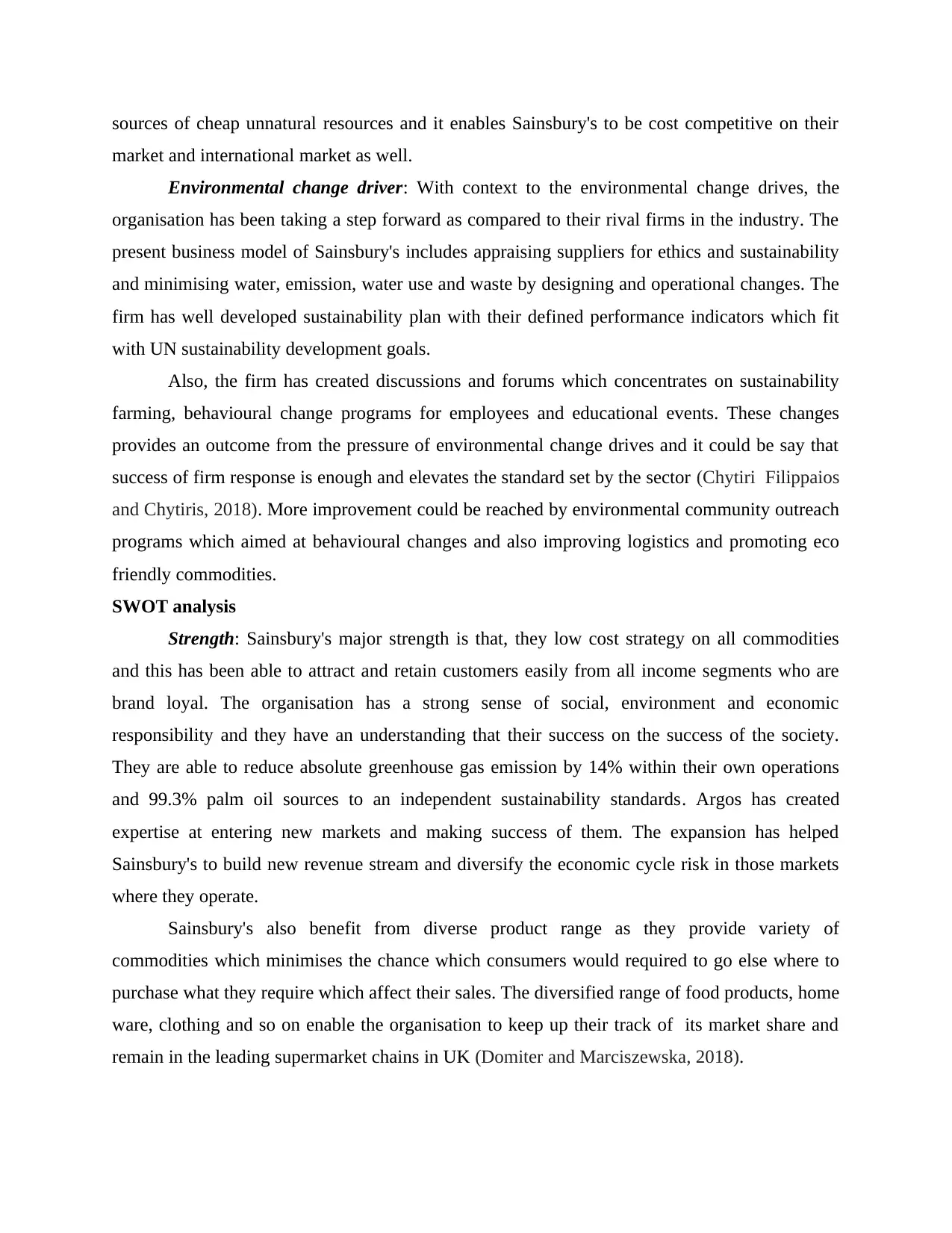
sources of cheap unnatural resources and it enables Sainsbury's to be cost competitive on their
market and international market as well.
Environmental change driver: With context to the environmental change drives, the
organisation has been taking a step forward as compared to their rival firms in the industry. The
present business model of Sainsbury's includes appraising suppliers for ethics and sustainability
and minimising water, emission, water use and waste by designing and operational changes. The
firm has well developed sustainability plan with their defined performance indicators which fit
with UN sustainability development goals.
Also, the firm has created discussions and forums which concentrates on sustainability
farming, behavioural change programs for employees and educational events. These changes
provides an outcome from the pressure of environmental change drives and it could be say that
success of firm response is enough and elevates the standard set by the sector (Chytiri Filippaios
and Chytiris, 2018). More improvement could be reached by environmental community outreach
programs which aimed at behavioural changes and also improving logistics and promoting eco
friendly commodities.
SWOT analysis
Strength: Sainsbury's major strength is that, they low cost strategy on all commodities
and this has been able to attract and retain customers easily from all income segments who are
brand loyal. The organisation has a strong sense of social, environment and economic
responsibility and they have an understanding that their success on the success of the society.
They are able to reduce absolute greenhouse gas emission by 14% within their own operations
and 99.3% palm oil sources to an independent sustainability standards. Argos has created
expertise at entering new markets and making success of them. The expansion has helped
Sainsbury's to build new revenue stream and diversify the economic cycle risk in those markets
where they operate.
Sainsbury's also benefit from diverse product range as they provide variety of
commodities which minimises the chance which consumers would required to go else where to
purchase what they require which affect their sales. The diversified range of food products, home
ware, clothing and so on enable the organisation to keep up their track of its market share and
remain in the leading supermarket chains in UK (Domiter and Marciszewska, 2018).
market and international market as well.
Environmental change driver: With context to the environmental change drives, the
organisation has been taking a step forward as compared to their rival firms in the industry. The
present business model of Sainsbury's includes appraising suppliers for ethics and sustainability
and minimising water, emission, water use and waste by designing and operational changes. The
firm has well developed sustainability plan with their defined performance indicators which fit
with UN sustainability development goals.
Also, the firm has created discussions and forums which concentrates on sustainability
farming, behavioural change programs for employees and educational events. These changes
provides an outcome from the pressure of environmental change drives and it could be say that
success of firm response is enough and elevates the standard set by the sector (Chytiri Filippaios
and Chytiris, 2018). More improvement could be reached by environmental community outreach
programs which aimed at behavioural changes and also improving logistics and promoting eco
friendly commodities.
SWOT analysis
Strength: Sainsbury's major strength is that, they low cost strategy on all commodities
and this has been able to attract and retain customers easily from all income segments who are
brand loyal. The organisation has a strong sense of social, environment and economic
responsibility and they have an understanding that their success on the success of the society.
They are able to reduce absolute greenhouse gas emission by 14% within their own operations
and 99.3% palm oil sources to an independent sustainability standards. Argos has created
expertise at entering new markets and making success of them. The expansion has helped
Sainsbury's to build new revenue stream and diversify the economic cycle risk in those markets
where they operate.
Sainsbury's also benefit from diverse product range as they provide variety of
commodities which minimises the chance which consumers would required to go else where to
purchase what they require which affect their sales. The diversified range of food products, home
ware, clothing and so on enable the organisation to keep up their track of its market share and
remain in the leading supermarket chains in UK (Domiter and Marciszewska, 2018).
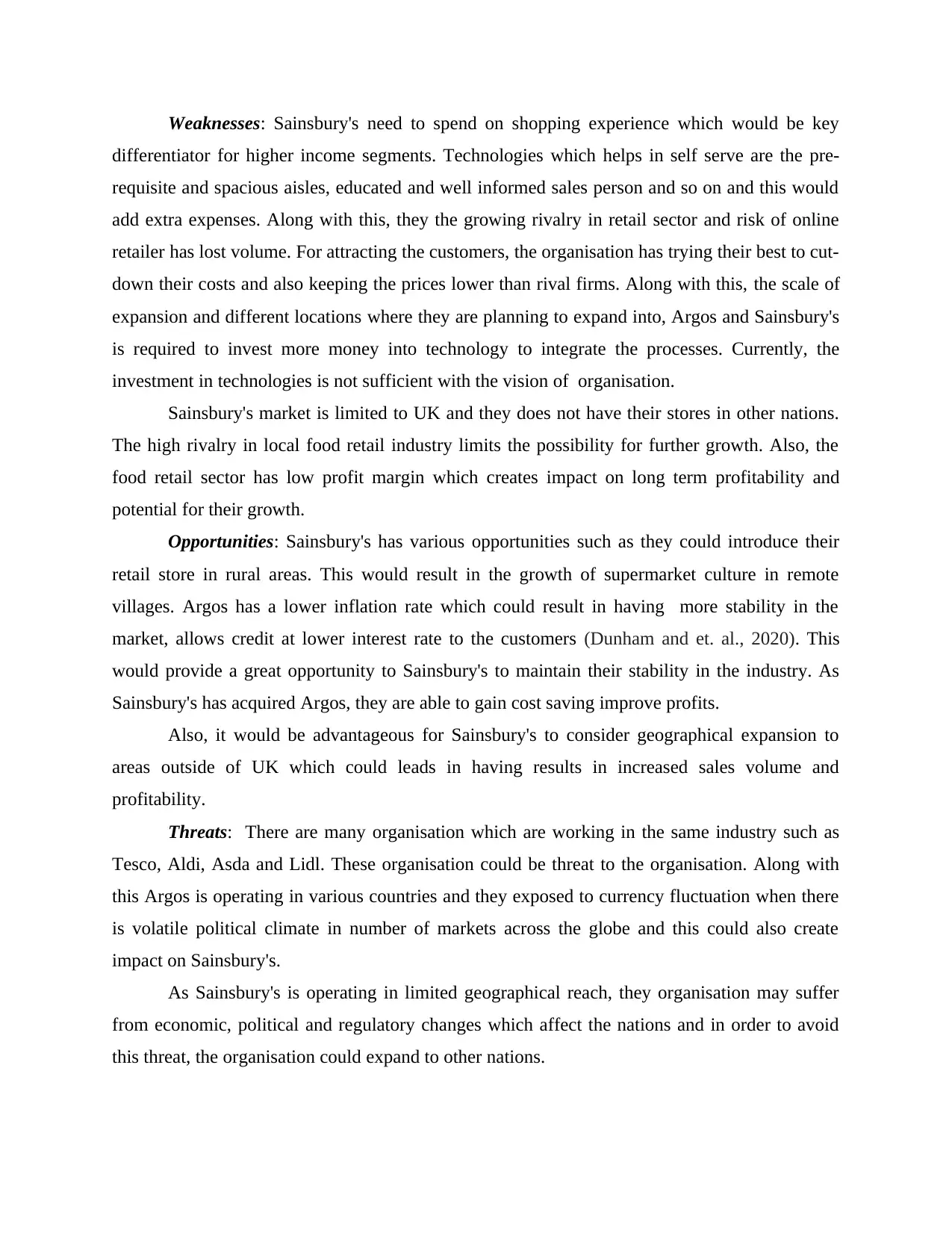
Weaknesses: Sainsbury's need to spend on shopping experience which would be key
differentiator for higher income segments. Technologies which helps in self serve are the pre-
requisite and spacious aisles, educated and well informed sales person and so on and this would
add extra expenses. Along with this, they the growing rivalry in retail sector and risk of online
retailer has lost volume. For attracting the customers, the organisation has trying their best to cut-
down their costs and also keeping the prices lower than rival firms. Along with this, the scale of
expansion and different locations where they are planning to expand into, Argos and Sainsbury's
is required to invest more money into technology to integrate the processes. Currently, the
investment in technologies is not sufficient with the vision of organisation.
Sainsbury's market is limited to UK and they does not have their stores in other nations.
The high rivalry in local food retail industry limits the possibility for further growth. Also, the
food retail sector has low profit margin which creates impact on long term profitability and
potential for their growth.
Opportunities: Sainsbury's has various opportunities such as they could introduce their
retail store in rural areas. This would result in the growth of supermarket culture in remote
villages. Argos has a lower inflation rate which could result in having more stability in the
market, allows credit at lower interest rate to the customers (Dunham and et. al., 2020). This
would provide a great opportunity to Sainsbury's to maintain their stability in the industry. As
Sainsbury's has acquired Argos, they are able to gain cost saving improve profits.
Also, it would be advantageous for Sainsbury's to consider geographical expansion to
areas outside of UK which could leads in having results in increased sales volume and
profitability.
Threats: There are many organisation which are working in the same industry such as
Tesco, Aldi, Asda and Lidl. These organisation could be threat to the organisation. Along with
this Argos is operating in various countries and they exposed to currency fluctuation when there
is volatile political climate in number of markets across the globe and this could also create
impact on Sainsbury's.
As Sainsbury's is operating in limited geographical reach, they organisation may suffer
from economic, political and regulatory changes which affect the nations and in order to avoid
this threat, the organisation could expand to other nations.
differentiator for higher income segments. Technologies which helps in self serve are the pre-
requisite and spacious aisles, educated and well informed sales person and so on and this would
add extra expenses. Along with this, they the growing rivalry in retail sector and risk of online
retailer has lost volume. For attracting the customers, the organisation has trying their best to cut-
down their costs and also keeping the prices lower than rival firms. Along with this, the scale of
expansion and different locations where they are planning to expand into, Argos and Sainsbury's
is required to invest more money into technology to integrate the processes. Currently, the
investment in technologies is not sufficient with the vision of organisation.
Sainsbury's market is limited to UK and they does not have their stores in other nations.
The high rivalry in local food retail industry limits the possibility for further growth. Also, the
food retail sector has low profit margin which creates impact on long term profitability and
potential for their growth.
Opportunities: Sainsbury's has various opportunities such as they could introduce their
retail store in rural areas. This would result in the growth of supermarket culture in remote
villages. Argos has a lower inflation rate which could result in having more stability in the
market, allows credit at lower interest rate to the customers (Dunham and et. al., 2020). This
would provide a great opportunity to Sainsbury's to maintain their stability in the industry. As
Sainsbury's has acquired Argos, they are able to gain cost saving improve profits.
Also, it would be advantageous for Sainsbury's to consider geographical expansion to
areas outside of UK which could leads in having results in increased sales volume and
profitability.
Threats: There are many organisation which are working in the same industry such as
Tesco, Aldi, Asda and Lidl. These organisation could be threat to the organisation. Along with
this Argos is operating in various countries and they exposed to currency fluctuation when there
is volatile political climate in number of markets across the globe and this could also create
impact on Sainsbury's.
As Sainsbury's is operating in limited geographical reach, they organisation may suffer
from economic, political and regulatory changes which affect the nations and in order to avoid
this threat, the organisation could expand to other nations.
⊘ This is a preview!⊘
Do you want full access?
Subscribe today to unlock all pages.

Trusted by 1+ million students worldwide
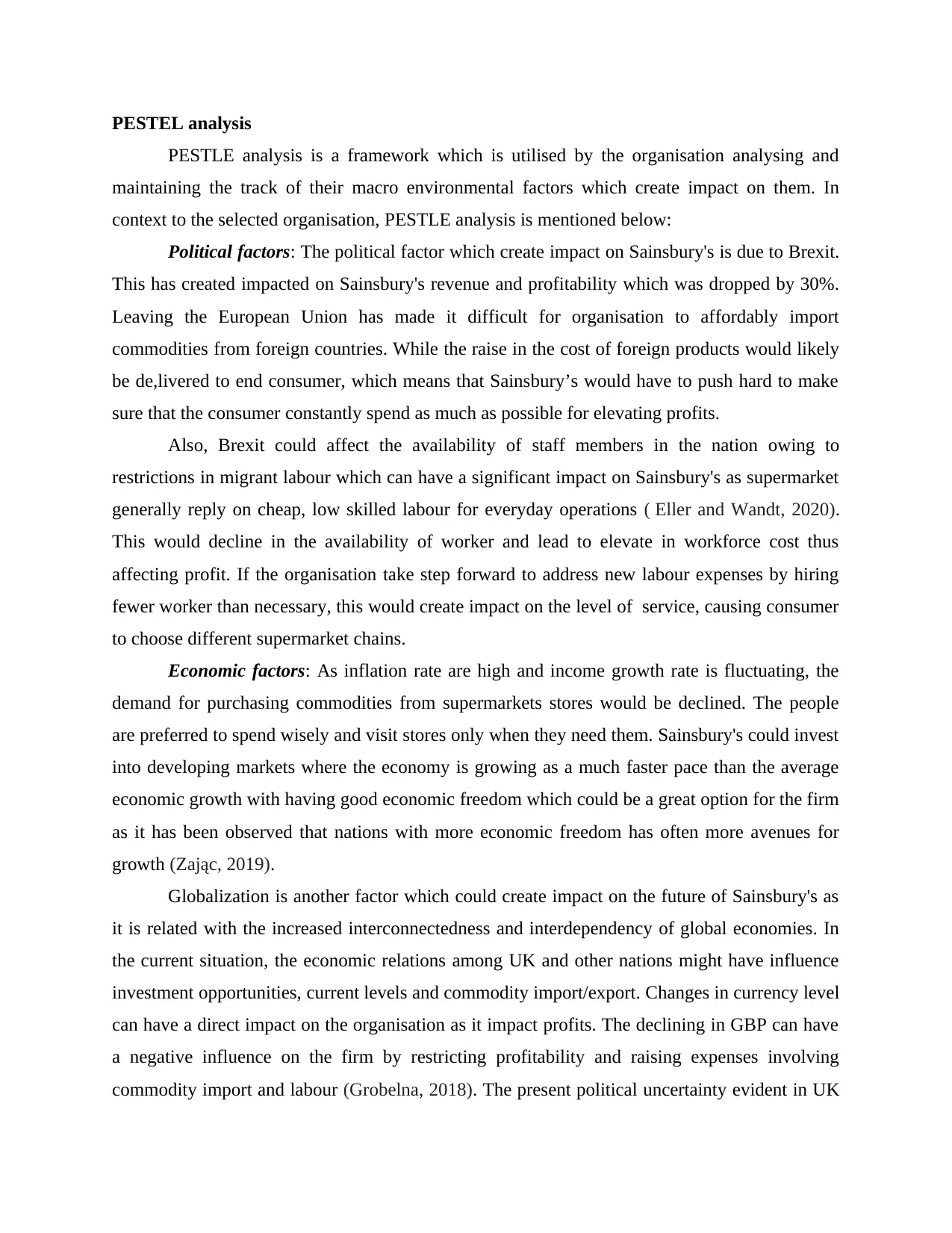
PESTEL analysis
PESTLE analysis is a framework which is utilised by the organisation analysing and
maintaining the track of their macro environmental factors which create impact on them. In
context to the selected organisation, PESTLE analysis is mentioned below:
Political factors: The political factor which create impact on Sainsbury's is due to Brexit.
This has created impacted on Sainsbury's revenue and profitability which was dropped by 30%.
Leaving the European Union has made it difficult for organisation to affordably import
commodities from foreign countries. While the raise in the cost of foreign products would likely
be de,livered to end consumer, which means that Sainsbury’s would have to push hard to make
sure that the consumer constantly spend as much as possible for elevating profits.
Also, Brexit could affect the availability of staff members in the nation owing to
restrictions in migrant labour which can have a significant impact on Sainsbury's as supermarket
generally reply on cheap, low skilled labour for everyday operations ( Eller and Wandt, 2020).
This would decline in the availability of worker and lead to elevate in workforce cost thus
affecting profit. If the organisation take step forward to address new labour expenses by hiring
fewer worker than necessary, this would create impact on the level of service, causing consumer
to choose different supermarket chains.
Economic factors: As inflation rate are high and income growth rate is fluctuating, the
demand for purchasing commodities from supermarkets stores would be declined. The people
are preferred to spend wisely and visit stores only when they need them. Sainsbury's could invest
into developing markets where the economy is growing as a much faster pace than the average
economic growth with having good economic freedom which could be a great option for the firm
as it has been observed that nations with more economic freedom has often more avenues for
growth (Zając, 2019).
Globalization is another factor which could create impact on the future of Sainsbury's as
it is related with the increased interconnectedness and interdependency of global economies. In
the current situation, the economic relations among UK and other nations might have influence
investment opportunities, current levels and commodity import/export. Changes in currency level
can have a direct impact on the organisation as it impact profits. The declining in GBP can have
a negative influence on the firm by restricting profitability and raising expenses involving
commodity import and labour (Grobelna, 2018). The present political uncertainty evident in UK
PESTLE analysis is a framework which is utilised by the organisation analysing and
maintaining the track of their macro environmental factors which create impact on them. In
context to the selected organisation, PESTLE analysis is mentioned below:
Political factors: The political factor which create impact on Sainsbury's is due to Brexit.
This has created impacted on Sainsbury's revenue and profitability which was dropped by 30%.
Leaving the European Union has made it difficult for organisation to affordably import
commodities from foreign countries. While the raise in the cost of foreign products would likely
be de,livered to end consumer, which means that Sainsbury’s would have to push hard to make
sure that the consumer constantly spend as much as possible for elevating profits.
Also, Brexit could affect the availability of staff members in the nation owing to
restrictions in migrant labour which can have a significant impact on Sainsbury's as supermarket
generally reply on cheap, low skilled labour for everyday operations ( Eller and Wandt, 2020).
This would decline in the availability of worker and lead to elevate in workforce cost thus
affecting profit. If the organisation take step forward to address new labour expenses by hiring
fewer worker than necessary, this would create impact on the level of service, causing consumer
to choose different supermarket chains.
Economic factors: As inflation rate are high and income growth rate is fluctuating, the
demand for purchasing commodities from supermarkets stores would be declined. The people
are preferred to spend wisely and visit stores only when they need them. Sainsbury's could invest
into developing markets where the economy is growing as a much faster pace than the average
economic growth with having good economic freedom which could be a great option for the firm
as it has been observed that nations with more economic freedom has often more avenues for
growth (Zając, 2019).
Globalization is another factor which could create impact on the future of Sainsbury's as
it is related with the increased interconnectedness and interdependency of global economies. In
the current situation, the economic relations among UK and other nations might have influence
investment opportunities, current levels and commodity import/export. Changes in currency level
can have a direct impact on the organisation as it impact profits. The declining in GBP can have
a negative influence on the firm by restricting profitability and raising expenses involving
commodity import and labour (Grobelna, 2018). The present political uncertainty evident in UK
Paraphrase This Document
Need a fresh take? Get an instant paraphrase of this document with our AI Paraphraser
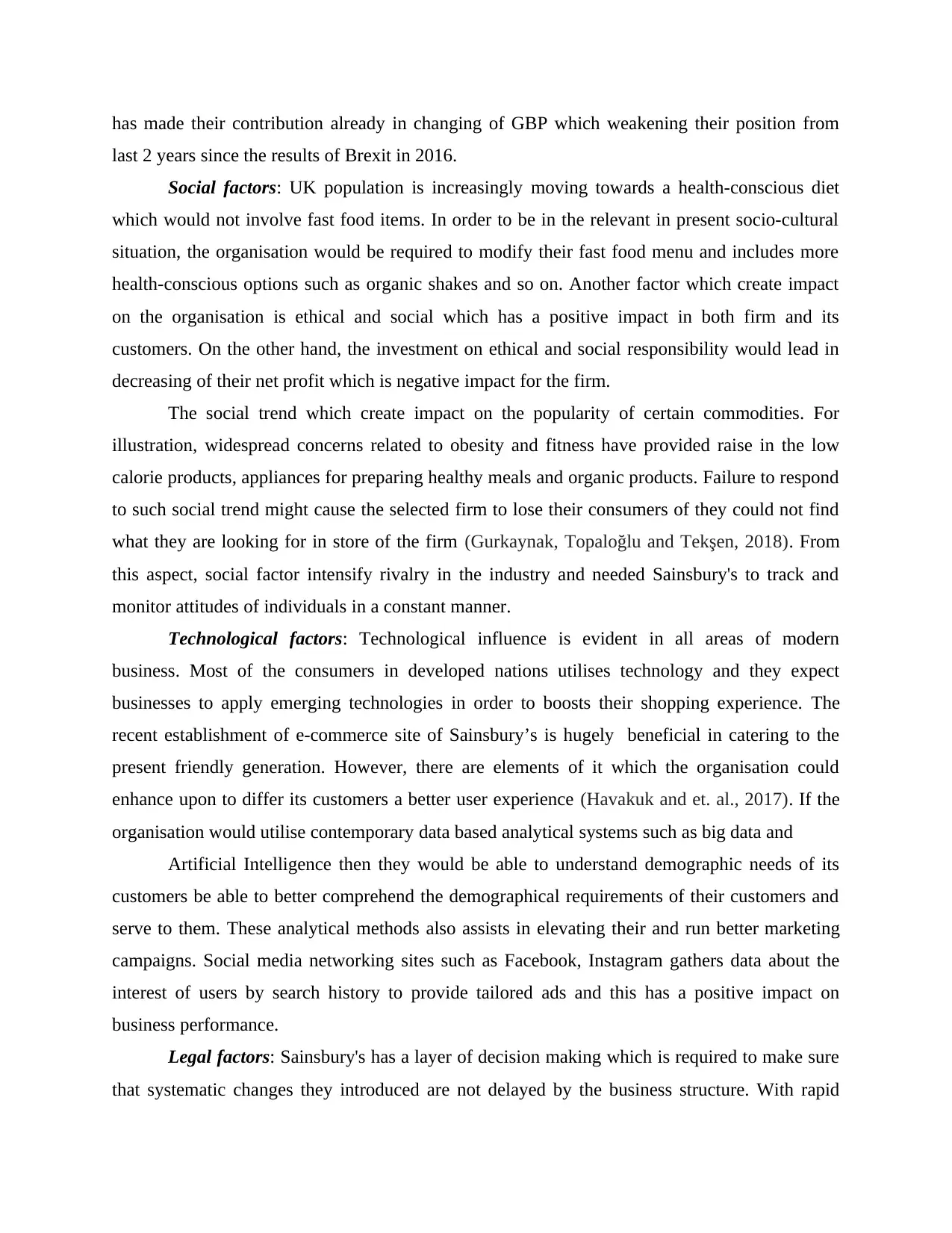
has made their contribution already in changing of GBP which weakening their position from
last 2 years since the results of Brexit in 2016.
Social factors: UK population is increasingly moving towards a health-conscious diet
which would not involve fast food items. In order to be in the relevant in present socio-cultural
situation, the organisation would be required to modify their fast food menu and includes more
health-conscious options such as organic shakes and so on. Another factor which create impact
on the organisation is ethical and social which has a positive impact in both firm and its
customers. On the other hand, the investment on ethical and social responsibility would lead in
decreasing of their net profit which is negative impact for the firm.
The social trend which create impact on the popularity of certain commodities. For
illustration, widespread concerns related to obesity and fitness have provided raise in the low
calorie products, appliances for preparing healthy meals and organic products. Failure to respond
to such social trend might cause the selected firm to lose their consumers of they could not find
what they are looking for in store of the firm (Gurkaynak, Topaloğlu and Tekşen, 2018). From
this aspect, social factor intensify rivalry in the industry and needed Sainsbury's to track and
monitor attitudes of individuals in a constant manner.
Technological factors: Technological influence is evident in all areas of modern
business. Most of the consumers in developed nations utilises technology and they expect
businesses to apply emerging technologies in order to boosts their shopping experience. The
recent establishment of e-commerce site of Sainsbury’s is hugely beneficial in catering to the
present friendly generation. However, there are elements of it which the organisation could
enhance upon to differ its customers a better user experience (Havakuk and et. al., 2017). If the
organisation would utilise contemporary data based analytical systems such as big data and
Artificial Intelligence then they would be able to understand demographic needs of its
customers be able to better comprehend the demographical requirements of their customers and
serve to them. These analytical methods also assists in elevating their and run better marketing
campaigns. Social media networking sites such as Facebook, Instagram gathers data about the
interest of users by search history to provide tailored ads and this has a positive impact on
business performance.
Legal factors: Sainsbury's has a layer of decision making which is required to make sure
that systematic changes they introduced are not delayed by the business structure. With rapid
last 2 years since the results of Brexit in 2016.
Social factors: UK population is increasingly moving towards a health-conscious diet
which would not involve fast food items. In order to be in the relevant in present socio-cultural
situation, the organisation would be required to modify their fast food menu and includes more
health-conscious options such as organic shakes and so on. Another factor which create impact
on the organisation is ethical and social which has a positive impact in both firm and its
customers. On the other hand, the investment on ethical and social responsibility would lead in
decreasing of their net profit which is negative impact for the firm.
The social trend which create impact on the popularity of certain commodities. For
illustration, widespread concerns related to obesity and fitness have provided raise in the low
calorie products, appliances for preparing healthy meals and organic products. Failure to respond
to such social trend might cause the selected firm to lose their consumers of they could not find
what they are looking for in store of the firm (Gurkaynak, Topaloğlu and Tekşen, 2018). From
this aspect, social factor intensify rivalry in the industry and needed Sainsbury's to track and
monitor attitudes of individuals in a constant manner.
Technological factors: Technological influence is evident in all areas of modern
business. Most of the consumers in developed nations utilises technology and they expect
businesses to apply emerging technologies in order to boosts their shopping experience. The
recent establishment of e-commerce site of Sainsbury’s is hugely beneficial in catering to the
present friendly generation. However, there are elements of it which the organisation could
enhance upon to differ its customers a better user experience (Havakuk and et. al., 2017). If the
organisation would utilise contemporary data based analytical systems such as big data and
Artificial Intelligence then they would be able to understand demographic needs of its
customers be able to better comprehend the demographical requirements of their customers and
serve to them. These analytical methods also assists in elevating their and run better marketing
campaigns. Social media networking sites such as Facebook, Instagram gathers data about the
interest of users by search history to provide tailored ads and this has a positive impact on
business performance.
Legal factors: Sainsbury's has a layer of decision making which is required to make sure
that systematic changes they introduced are not delayed by the business structure. With rapid
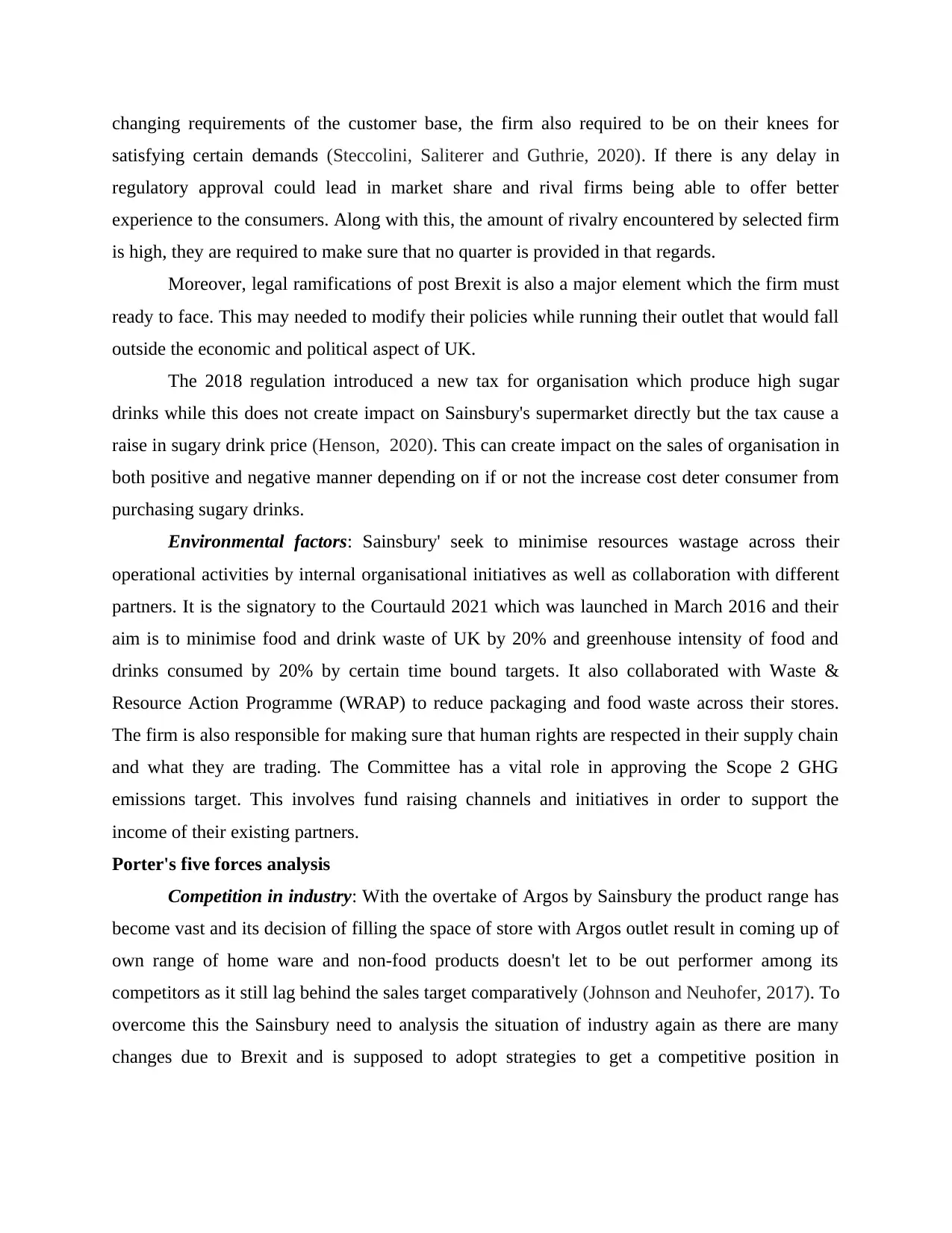
changing requirements of the customer base, the firm also required to be on their knees for
satisfying certain demands (Steccolini, Saliterer and Guthrie, 2020). If there is any delay in
regulatory approval could lead in market share and rival firms being able to offer better
experience to the consumers. Along with this, the amount of rivalry encountered by selected firm
is high, they are required to make sure that no quarter is provided in that regards.
Moreover, legal ramifications of post Brexit is also a major element which the firm must
ready to face. This may needed to modify their policies while running their outlet that would fall
outside the economic and political aspect of UK.
The 2018 regulation introduced a new tax for organisation which produce high sugar
drinks while this does not create impact on Sainsbury's supermarket directly but the tax cause a
raise in sugary drink price (Henson, 2020). This can create impact on the sales of organisation in
both positive and negative manner depending on if or not the increase cost deter consumer from
purchasing sugary drinks.
Environmental factors: Sainsbury' seek to minimise resources wastage across their
operational activities by internal organisational initiatives as well as collaboration with different
partners. It is the signatory to the Courtauld 2021 which was launched in March 2016 and their
aim is to minimise food and drink waste of UK by 20% and greenhouse intensity of food and
drinks consumed by 20% by certain time bound targets. It also collaborated with Waste &
Resource Action Programme (WRAP) to reduce packaging and food waste across their stores.
The firm is also responsible for making sure that human rights are respected in their supply chain
and what they are trading. The Committee has a vital role in approving the Scope 2 GHG
emissions target. This involves fund raising channels and initiatives in order to support the
income of their existing partners.
Porter's five forces analysis
Competition in industry: With the overtake of Argos by Sainsbury the product range has
become vast and its decision of filling the space of store with Argos outlet result in coming up of
own range of home ware and non-food products doesn't let to be out performer among its
competitors as it still lag behind the sales target comparatively (Johnson and Neuhofer, 2017). To
overcome this the Sainsbury need to analysis the situation of industry again as there are many
changes due to Brexit and is supposed to adopt strategies to get a competitive position in
satisfying certain demands (Steccolini, Saliterer and Guthrie, 2020). If there is any delay in
regulatory approval could lead in market share and rival firms being able to offer better
experience to the consumers. Along with this, the amount of rivalry encountered by selected firm
is high, they are required to make sure that no quarter is provided in that regards.
Moreover, legal ramifications of post Brexit is also a major element which the firm must
ready to face. This may needed to modify their policies while running their outlet that would fall
outside the economic and political aspect of UK.
The 2018 regulation introduced a new tax for organisation which produce high sugar
drinks while this does not create impact on Sainsbury's supermarket directly but the tax cause a
raise in sugary drink price (Henson, 2020). This can create impact on the sales of organisation in
both positive and negative manner depending on if or not the increase cost deter consumer from
purchasing sugary drinks.
Environmental factors: Sainsbury' seek to minimise resources wastage across their
operational activities by internal organisational initiatives as well as collaboration with different
partners. It is the signatory to the Courtauld 2021 which was launched in March 2016 and their
aim is to minimise food and drink waste of UK by 20% and greenhouse intensity of food and
drinks consumed by 20% by certain time bound targets. It also collaborated with Waste &
Resource Action Programme (WRAP) to reduce packaging and food waste across their stores.
The firm is also responsible for making sure that human rights are respected in their supply chain
and what they are trading. The Committee has a vital role in approving the Scope 2 GHG
emissions target. This involves fund raising channels and initiatives in order to support the
income of their existing partners.
Porter's five forces analysis
Competition in industry: With the overtake of Argos by Sainsbury the product range has
become vast and its decision of filling the space of store with Argos outlet result in coming up of
own range of home ware and non-food products doesn't let to be out performer among its
competitors as it still lag behind the sales target comparatively (Johnson and Neuhofer, 2017). To
overcome this the Sainsbury need to analysis the situation of industry again as there are many
changes due to Brexit and is supposed to adopt strategies to get a competitive position in
⊘ This is a preview!⊘
Do you want full access?
Subscribe today to unlock all pages.

Trusted by 1+ million students worldwide
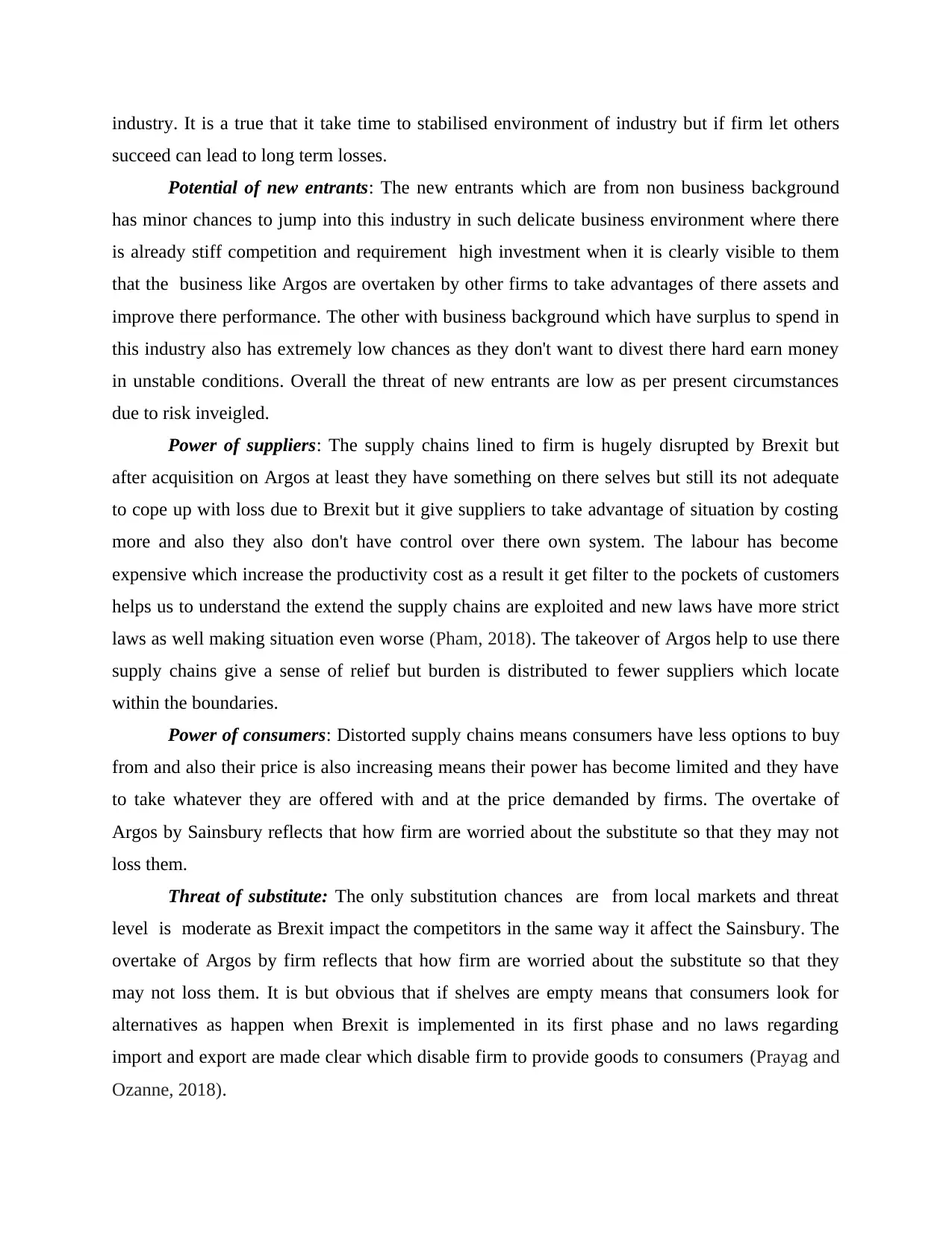
industry. It is a true that it take time to stabilised environment of industry but if firm let others
succeed can lead to long term losses.
Potential of new entrants: The new entrants which are from non business background
has minor chances to jump into this industry in such delicate business environment where there
is already stiff competition and requirement high investment when it is clearly visible to them
that the business like Argos are overtaken by other firms to take advantages of there assets and
improve there performance. The other with business background which have surplus to spend in
this industry also has extremely low chances as they don't want to divest there hard earn money
in unstable conditions. Overall the threat of new entrants are low as per present circumstances
due to risk inveigled.
Power of suppliers: The supply chains lined to firm is hugely disrupted by Brexit but
after acquisition on Argos at least they have something on there selves but still its not adequate
to cope up with loss due to Brexit but it give suppliers to take advantage of situation by costing
more and also they also don't have control over there own system. The labour has become
expensive which increase the productivity cost as a result it get filter to the pockets of customers
helps us to understand the extend the supply chains are exploited and new laws have more strict
laws as well making situation even worse (Pham, 2018). The takeover of Argos help to use there
supply chains give a sense of relief but burden is distributed to fewer suppliers which locate
within the boundaries.
Power of consumers: Distorted supply chains means consumers have less options to buy
from and also their price is also increasing means their power has become limited and they have
to take whatever they are offered with and at the price demanded by firms. The overtake of
Argos by Sainsbury reflects that how firm are worried about the substitute so that they may not
loss them.
Threat of substitute: The only substitution chances are from local markets and threat
level is moderate as Brexit impact the competitors in the same way it affect the Sainsbury. The
overtake of Argos by firm reflects that how firm are worried about the substitute so that they
may not loss them. It is but obvious that if shelves are empty means that consumers look for
alternatives as happen when Brexit is implemented in its first phase and no laws regarding
import and export are made clear which disable firm to provide goods to consumers (Prayag and
Ozanne, 2018).
succeed can lead to long term losses.
Potential of new entrants: The new entrants which are from non business background
has minor chances to jump into this industry in such delicate business environment where there
is already stiff competition and requirement high investment when it is clearly visible to them
that the business like Argos are overtaken by other firms to take advantages of there assets and
improve there performance. The other with business background which have surplus to spend in
this industry also has extremely low chances as they don't want to divest there hard earn money
in unstable conditions. Overall the threat of new entrants are low as per present circumstances
due to risk inveigled.
Power of suppliers: The supply chains lined to firm is hugely disrupted by Brexit but
after acquisition on Argos at least they have something on there selves but still its not adequate
to cope up with loss due to Brexit but it give suppliers to take advantage of situation by costing
more and also they also don't have control over there own system. The labour has become
expensive which increase the productivity cost as a result it get filter to the pockets of customers
helps us to understand the extend the supply chains are exploited and new laws have more strict
laws as well making situation even worse (Pham, 2018). The takeover of Argos help to use there
supply chains give a sense of relief but burden is distributed to fewer suppliers which locate
within the boundaries.
Power of consumers: Distorted supply chains means consumers have less options to buy
from and also their price is also increasing means their power has become limited and they have
to take whatever they are offered with and at the price demanded by firms. The overtake of
Argos by Sainsbury reflects that how firm are worried about the substitute so that they may not
loss them.
Threat of substitute: The only substitution chances are from local markets and threat
level is moderate as Brexit impact the competitors in the same way it affect the Sainsbury. The
overtake of Argos by firm reflects that how firm are worried about the substitute so that they
may not loss them. It is but obvious that if shelves are empty means that consumers look for
alternatives as happen when Brexit is implemented in its first phase and no laws regarding
import and export are made clear which disable firm to provide goods to consumers (Prayag and
Ozanne, 2018).
Paraphrase This Document
Need a fresh take? Get an instant paraphrase of this document with our AI Paraphraser
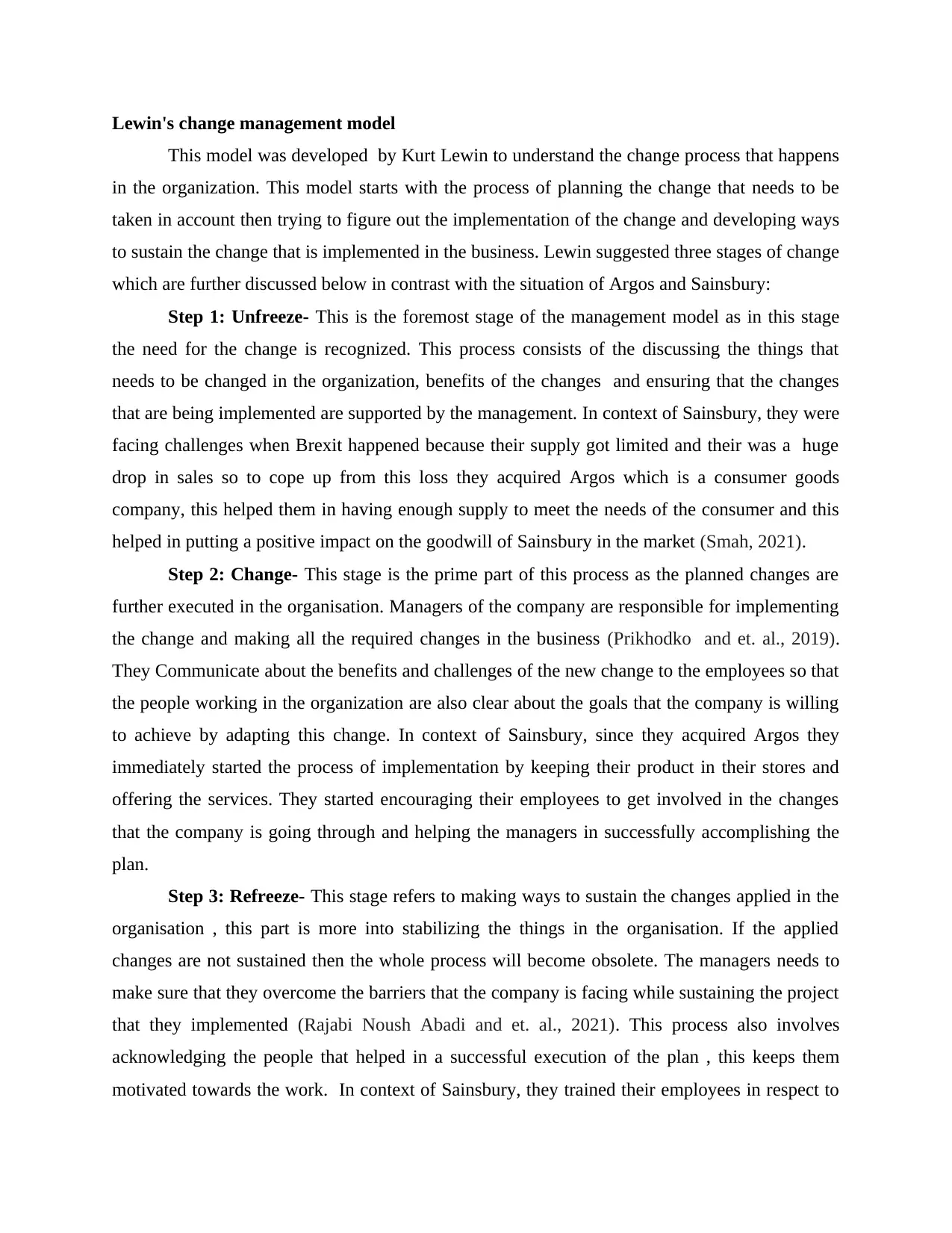
Lewin's change management model
This model was developed by Kurt Lewin to understand the change process that happens
in the organization. This model starts with the process of planning the change that needs to be
taken in account then trying to figure out the implementation of the change and developing ways
to sustain the change that is implemented in the business. Lewin suggested three stages of change
which are further discussed below in contrast with the situation of Argos and Sainsbury:
Step 1: Unfreeze- This is the foremost stage of the management model as in this stage
the need for the change is recognized. This process consists of the discussing the things that
needs to be changed in the organization, benefits of the changes and ensuring that the changes
that are being implemented are supported by the management. In context of Sainsbury, they were
facing challenges when Brexit happened because their supply got limited and their was a huge
drop in sales so to cope up from this loss they acquired Argos which is a consumer goods
company, this helped them in having enough supply to meet the needs of the consumer and this
helped in putting a positive impact on the goodwill of Sainsbury in the market (Smah, 2021).
Step 2: Change- This stage is the prime part of this process as the planned changes are
further executed in the organisation. Managers of the company are responsible for implementing
the change and making all the required changes in the business (Prikhodko and et. al., 2019).
They Communicate about the benefits and challenges of the new change to the employees so that
the people working in the organization are also clear about the goals that the company is willing
to achieve by adapting this change. In context of Sainsbury, since they acquired Argos they
immediately started the process of implementation by keeping their product in their stores and
offering the services. They started encouraging their employees to get involved in the changes
that the company is going through and helping the managers in successfully accomplishing the
plan.
Step 3: Refreeze- This stage refers to making ways to sustain the changes applied in the
organisation , this part is more into stabilizing the things in the organisation. If the applied
changes are not sustained then the whole process will become obsolete. The managers needs to
make sure that they overcome the barriers that the company is facing while sustaining the project
that they implemented (Rajabi Noush Abadi and et. al., 2021). This process also involves
acknowledging the people that helped in a successful execution of the plan , this keeps them
motivated towards the work. In context of Sainsbury, they trained their employees in respect to
This model was developed by Kurt Lewin to understand the change process that happens
in the organization. This model starts with the process of planning the change that needs to be
taken in account then trying to figure out the implementation of the change and developing ways
to sustain the change that is implemented in the business. Lewin suggested three stages of change
which are further discussed below in contrast with the situation of Argos and Sainsbury:
Step 1: Unfreeze- This is the foremost stage of the management model as in this stage
the need for the change is recognized. This process consists of the discussing the things that
needs to be changed in the organization, benefits of the changes and ensuring that the changes
that are being implemented are supported by the management. In context of Sainsbury, they were
facing challenges when Brexit happened because their supply got limited and their was a huge
drop in sales so to cope up from this loss they acquired Argos which is a consumer goods
company, this helped them in having enough supply to meet the needs of the consumer and this
helped in putting a positive impact on the goodwill of Sainsbury in the market (Smah, 2021).
Step 2: Change- This stage is the prime part of this process as the planned changes are
further executed in the organisation. Managers of the company are responsible for implementing
the change and making all the required changes in the business (Prikhodko and et. al., 2019).
They Communicate about the benefits and challenges of the new change to the employees so that
the people working in the organization are also clear about the goals that the company is willing
to achieve by adapting this change. In context of Sainsbury, since they acquired Argos they
immediately started the process of implementation by keeping their product in their stores and
offering the services. They started encouraging their employees to get involved in the changes
that the company is going through and helping the managers in successfully accomplishing the
plan.
Step 3: Refreeze- This stage refers to making ways to sustain the changes applied in the
organisation , this part is more into stabilizing the things in the organisation. If the applied
changes are not sustained then the whole process will become obsolete. The managers needs to
make sure that they overcome the barriers that the company is facing while sustaining the project
that they implemented (Rajabi Noush Abadi and et. al., 2021). This process also involves
acknowledging the people that helped in a successful execution of the plan , this keeps them
motivated towards the work. In context of Sainsbury, they trained their employees in respect to
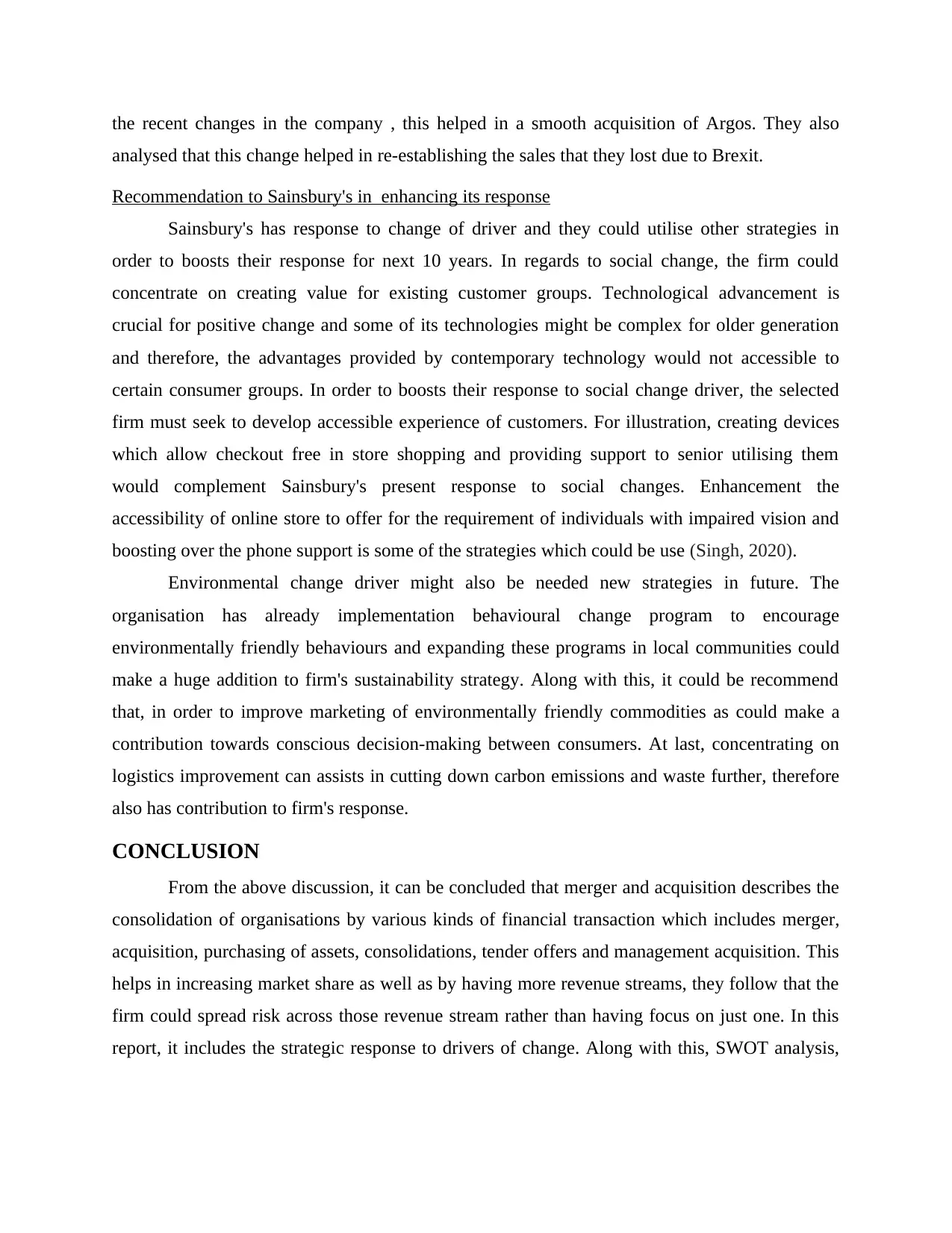
the recent changes in the company , this helped in a smooth acquisition of Argos. They also
analysed that this change helped in re-establishing the sales that they lost due to Brexit.
Recommendation to Sainsbury's in enhancing its response
Sainsbury's has response to change of driver and they could utilise other strategies in
order to boosts their response for next 10 years. In regards to social change, the firm could
concentrate on creating value for existing customer groups. Technological advancement is
crucial for positive change and some of its technologies might be complex for older generation
and therefore, the advantages provided by contemporary technology would not accessible to
certain consumer groups. In order to boosts their response to social change driver, the selected
firm must seek to develop accessible experience of customers. For illustration, creating devices
which allow checkout free in store shopping and providing support to senior utilising them
would complement Sainsbury's present response to social changes. Enhancement the
accessibility of online store to offer for the requirement of individuals with impaired vision and
boosting over the phone support is some of the strategies which could be use (Singh, 2020).
Environmental change driver might also be needed new strategies in future. The
organisation has already implementation behavioural change program to encourage
environmentally friendly behaviours and expanding these programs in local communities could
make a huge addition to firm's sustainability strategy. Along with this, it could be recommend
that, in order to improve marketing of environmentally friendly commodities as could make a
contribution towards conscious decision-making between consumers. At last, concentrating on
logistics improvement can assists in cutting down carbon emissions and waste further, therefore
also has contribution to firm's response.
CONCLUSION
From the above discussion, it can be concluded that merger and acquisition describes the
consolidation of organisations by various kinds of financial transaction which includes merger,
acquisition, purchasing of assets, consolidations, tender offers and management acquisition. This
helps in increasing market share as well as by having more revenue streams, they follow that the
firm could spread risk across those revenue stream rather than having focus on just one. In this
report, it includes the strategic response to drivers of change. Along with this, SWOT analysis,
analysed that this change helped in re-establishing the sales that they lost due to Brexit.
Recommendation to Sainsbury's in enhancing its response
Sainsbury's has response to change of driver and they could utilise other strategies in
order to boosts their response for next 10 years. In regards to social change, the firm could
concentrate on creating value for existing customer groups. Technological advancement is
crucial for positive change and some of its technologies might be complex for older generation
and therefore, the advantages provided by contemporary technology would not accessible to
certain consumer groups. In order to boosts their response to social change driver, the selected
firm must seek to develop accessible experience of customers. For illustration, creating devices
which allow checkout free in store shopping and providing support to senior utilising them
would complement Sainsbury's present response to social changes. Enhancement the
accessibility of online store to offer for the requirement of individuals with impaired vision and
boosting over the phone support is some of the strategies which could be use (Singh, 2020).
Environmental change driver might also be needed new strategies in future. The
organisation has already implementation behavioural change program to encourage
environmentally friendly behaviours and expanding these programs in local communities could
make a huge addition to firm's sustainability strategy. Along with this, it could be recommend
that, in order to improve marketing of environmentally friendly commodities as could make a
contribution towards conscious decision-making between consumers. At last, concentrating on
logistics improvement can assists in cutting down carbon emissions and waste further, therefore
also has contribution to firm's response.
CONCLUSION
From the above discussion, it can be concluded that merger and acquisition describes the
consolidation of organisations by various kinds of financial transaction which includes merger,
acquisition, purchasing of assets, consolidations, tender offers and management acquisition. This
helps in increasing market share as well as by having more revenue streams, they follow that the
firm could spread risk across those revenue stream rather than having focus on just one. In this
report, it includes the strategic response to drivers of change. Along with this, SWOT analysis,
⊘ This is a preview!⊘
Do you want full access?
Subscribe today to unlock all pages.

Trusted by 1+ million students worldwide
1 out of 15
Related Documents
Your All-in-One AI-Powered Toolkit for Academic Success.
+13062052269
info@desklib.com
Available 24*7 on WhatsApp / Email
![[object Object]](/_next/static/media/star-bottom.7253800d.svg)
Unlock your academic potential
Copyright © 2020–2025 A2Z Services. All Rights Reserved. Developed and managed by ZUCOL.





